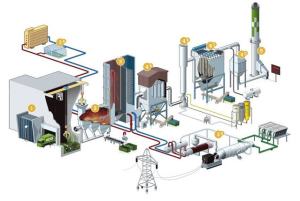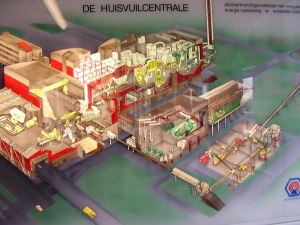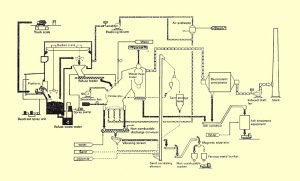Some time ago, I wrote about the vehement opposition of the U.S. environmental movement to garbage incineration (a brief primer on plumes), a position not shared by environmentalists anywhere else except the UK. I asked Milieudefensie, the Dutch Friends of the Earth, to offer me some thoughts on the subject, to try to determine if I had somehow missed the secret garbage underground in continental Europe. Here’s what they had to say:
“Waste management is not a subject Milieudefensie concerns itself with at the moment, because things are properly arranged in the Netherlands. Other environmental topics, such as climate change, make a more urgent claim on our attention.”
The way things are arranged in the Netherlands at the moment is to rely primarily on re-use and recycling and secondarily on incineration. Thirteen incinerators operate across the country, some in the most densely populated areas, a few others in the rural outback. Landfilling takes place only insofar as there is insufficient incinerator capacity and requires a special waiver. Hazardous wastes which are unsafe to burn are also landfilled. Germany has an even stronger emphasis on incineration, with plants all over the country, and no movement opposing them. An official noted that people oppose incinerators during the planning phases. Resistance dies down after the plants become operational.
There are concerns. Fine particulates are released in exhaust gases and their health impacts are not very well understood. Fly ash is highly toxic and must be buried or incinerated in special rotating kiln incinerators. Toxic chemicals may escape when a plant is powered up or down. That they are so much more visible than lowly landfill, I’m sure, doesn’t increase their popularity either. It is so much easier not to think about the deleterious but invisible effects of an invisible landfill than it is to ignore a very high smokestack belching clouds, with heaven knows what in them.
The EPA meanwhile appears to be solidly in line with Milieudefensie in its evaluation of various disposal methods when considered in terms of their net effect on global warming. Its report Solid Waste Management and Green House Gases rank orders the different methods from least to most harmful:
> source reduction (i.e., reduced consumption or reduced use of materials in consumption)
> recycling
> composting
> incineration
> landfilling
Obviously there are more attractive options than burning trash, but conventional landfilling isn’t one of them. (Experiments with landfill are under way to make them less environmentally wasteful, so to speak.)
I also ran into a different evaluation of waste disposal methods, by a Dr. Jeffrey Morris, which tries to attach a monetary cost to each method, calculating operating and environmental costs and subtracting environmental benefits. Constituent prices vary by location and over time, so this model is more difficult to generalize from. However, a few specific examples from that calculation, showed incineration finishing dead last. This is not terribly surprising, since operating costs for incineration are generally high while landfilling is still cheap in many places. A landfill, no matter how carefully engineered, doesn’t come close to an incinerator in terms of capital costs.
Incineration, unfortunately, may be too expensive outside the industrialized west. While waste prevention is more attractive than any other option, the total elimination of waste is an unlikely prospect. It follows that landfill will just have to be organized to do better–capturing methane more effectively and delivering more usable fuel. And in the meantime, the economy is in process of imposing a new frugality, which will eventually lead to less waste, if it isn’t doing so already.



